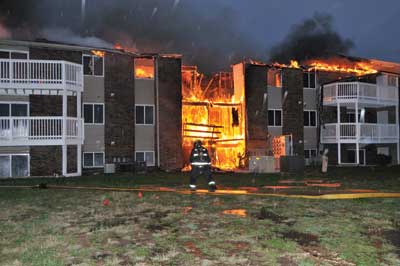By John “Skip” Coleman, Technical Editor
This month’s Roundtable question concerns your department’s morale. Several factors contribute to the morale of a department. For one, politics have intruded into firefighters’ daily lives. Some of you are from states that are “right-to-work” states, but others have legislators vying to take negotiated rights away from unions. As the nightly news demonstrates, this hasn’t set well with a majority of union firefighters. This past spring, several states presented legislation that reduces the rights of unions. This November, several states will vote on the repeal of some of the legislation that has been enforced. A second factor affecting morale is the never-ending budget crunch. Union or not, we are continually being asked to do more with less—not only reductions in staffing but in apparatus, tools, and station supplies. A third factor is the problem of firefighter suicide, which has increased recently across the country. Thus, this month’s Roundtable question is, What is your department doing to boost morale? Go to http://emberly.fireengineering.com” target=”_blank”>emberly.fireengineering.com and answer this question and see what others have posted.
FIRE LIFE
In her column “What Every Firefighter’s Spouse Should Know,” Anne Gagliano writes in “The Hard Conversations: Dealing with the Fix-It Mentality”: “Firefighters are problem solvers; they’re good at it; it’s what they’re paid to do. But what happens when these fixers try to fix you, their spouse? Instead of putting the ‘fire out,’ the ‘fix-it’ mentality can actually cause small explosions at home.”

What’s cooking at home or at your fire station? Have you tried Bagpiper’s Scotch Eggs, Fruit Pie with Date-Nut Crust, or a South Side Dog? Cook with Rip Esselstyn, Craig Nelson, and Kipp Rix. See their step-by-step recipes and instructions on Fire Life.
If you missed any of Fire Department of New York (FDNY) Lieutenant (Ret.) Kevin Shea’s multipart video series on his recent safari to Africa, you can view the segments at www.firelife.com. Travel with him as he hunts elands, warthogs, and other wild animals.
 |
| PHOTO OF THE DAY: The Indianapolis, Speedway, Wayne Township, Pike Township, and Plainfield (IN) fire departments battled a three-alarm fire in an apartment complex. At least 30 units were destroyed. A working fire was declared before the first company arrived; more than 100 firefighters took about two hours to bring the fire under control. The fire walls held a significant portion of the fire in check. (Photo by John M. Buckman III, State Fire Training Director.) Send your Photo of the Day submissions to Online Editor Pete Prochilo (peterp@pennwell.com). |
FEATURED ARTICLES
Jonathon Steed gives us unique insight into being promoted to officer at a young age and provides some excellent basic leadership ideas to help with the transition. He writes: “In the fire service, the face of leadership appears to be changing—it seems to be getting younger. Why is this? Older members are retiring earlier, the turnover rate is increasing, and recent trends regarding fire science education make the younger officer candidate with a college degree more appealing on paper. Regardless of why this is happening, it is affecting more and more departments across the nation.”
Dave Dalrymple outlines the step-by-step actions necessary for successful vehicle extrication in his article, “First Ten Minutes, Best Practices Approach to MVC.” If you are responsible for responding to motor vehicle accidents, use his two-part article as a training aid for you and your crew.
Joseph McClelland reviews rapid intervention team procedures in “Fundamentals of RIT.” He writes: “The role of the rapid intervention team (RIT) is an essential function that must be staffed at any building fire. Some view the assignment as boring or as a task that keeps their crew from getting into the action. RIT is an assignment that must be taken seriously at all times. You never know when a Mayday may be transmitted and you will be called to action to aid a fellow firefighter in trouble.” He discusses some fundamental steps a RIT must take at a fire scene prior to deployment, the tasks from dispatch to just before entering the structure in the event of a Mayday, suggested tools, and the functions of each RIT member.
FDNY Battalion Chief Daniel Sheridan reminds us that this is the season for responding to odors of smoke: “The heating season is upon us here in the Northeast. Usually this time of year people are turning on their heating systems for the first time since the spring. Oil burners that are dirty will spew out dirty nasty black smoke. Some oil burners will be on their last legs and have more serious issues. We will be receiving lots of calls for an odor of smoke in the next few months.”
COMMUNITY MEMBER OF THE MONTH
 |
Name: Ariel Villarreal. Department: Martin County (FL) Fire Rescue. Title/rank: Bureau chief-training & safety. Years of public service: 22. Agency structure: Paid department. Professional qualifications: State of Florida fire officer II, fire service instructor III, live fire instructor I; member, USAR FL-TF2. Topics you provide training for: fire science course programs, officer development programs, in-service training, firefighter I & II recruit training, flashover training, engine company operations. |
More Fire Engineering Issue Articles
Fire Engineering Archives

